- Clone
- A17020B (See other available formats)
- Regulatory Status
- RUO
- Other Names
- S6, 40S ribosomal protein S6
- Isotype
- Mouse IgG1, κ
- Ave. Rating
- Submit a Review
- Product Citations
- publications
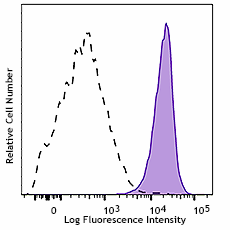
-

Human peripheral blood lymphocytes were stimulated with (filled histogram) or without (open histogram) Cell Activation Cocktail without Brefeldin A (Cat. No. 423302) for 15 minutes, fixed with Fixation Buffer, permeabilied with True-Phos™ Perm Buffer (Cat. No. 425401), and intracellularly stained with anti-RPS6 Phosopho (Ser235/Ser236) (clone A17020B) PE/Cyanine7.
| Cat # | Size | Price | Quantity Check Availability | Save | ||
|---|---|---|---|---|---|---|
| 608605 | 25 tests | 136 CHF | ||||
| 608606 | 100 tests | 358 CHF | ||||
Ribosomal protein S6 (RPS6) is a key component of the small 40S ribosomal subunit and is the major substrate of protein kinases in eukaryotic ribosomes. In response to various cellular stimuli such as mitogenic stimulation, insulin, and increased nutrient availability, upstream kinases such as RSK and p70 kinases phosphorylate RPS6 at multiple serine sites. These modifications facilitate the recruitment of the 7-methylguanasine cap complex, thereby promoting the assembly of the translational pre-initiation complex and increased cellular protein synthesis capacity. RPS6 has been shown to be hyperphosphorylated in certain cancers, and phosphorylation is a critical determinant of pancreatic β–cell size and systemic glucose homeostasis function in diabeteic mouse models.
Product DetailsProduct Details
- Verified Reactivity
- Human, Mouse
- Antibody Type
- Monoclonal
- Host Species
- Mouse
- Immunogen
- Synthetic peptide from human RPS6 phosphorylated at Serines 235 and 236
- Formulation
- Phosphate-buffered solution, pH 7.2, containing 0.09% sodium azide and BSA (origin USA)
- Preparation
- The antibody was purified by affinity chromatography and conjugated with PE/Cyanine7 under optimal conditions.
- Concentration
- Lot-specific (to obtain lot-specific concentration and expiration, please enter the lot number in our Certificate of Analysis online tool.)
- Storage & Handling
- The antibody solution should be stored undiluted between 2°C and 8°C, and protected from prolonged exposure to light. Do not freeze.
- Application
-
ICFC - Quality tested
- Recommended Usage
-
Each lot of this antibody is quality control tested by intracellular flow cytometry using our True-Phos™ Perm Buffer in Whole Blood Protocol. For flow cytometric staining, the suggested use of this reagent is 5 µl per million cells in 100 µl staining volume or 5 µl per 100 µl of whole blood.
- Excitation Laser
-
Blue Laser (488 nm)
Green Laser (532 nm)/Yellow-Green Laser (561 nm)
- Application Notes
-
Due to complete conservation of the immunizing sequence between humans, mouse and rat, this clone is is predicted to react with rat RPS6 phosphorylated at serines 235 and 236.
- Product Citations
-
- RRID
-
AB_2750307 (BioLegend Cat. No. 608605)
AB_2750308 (BioLegend Cat. No. 608606)
Antigen Details
- Structure
- RPS6 is a 249 amino acid protein with a predicted molecular weight of 28.6 kD.
- Distribution
-
Cytosol, nucleus, ER, ubiquitous expression.
- Function
- Phosphorylation events at a cluster of serine residues (Ser 235, 236, 240, and 244) at the carboxy-terminus of RPS6 results in increased global translational efficiency. These sites are dephosphorylated during growth arrest.
- Interaction
- RPS6AK1 and RPS6AK3; other subunits of 40S ribosomal complex.
- Biology Area
- Cell Biology, Cell Proliferation and Viability, Protein Synthesis, Signal Transduction
- Molecular Family
- Nuclear Markers, Phospho-Proteins
- Antigen References
-
- Jefferies HB, et al. 1997. EMBO J. 16:3693.
- Ruvinsky I, et al. 2005. Genes. Dev.19:2199.
- Chumacher AM, et al. 2006. Biochemistry. 45:13614
- Roux PP, et al. 2007. J. Biol. Chem. 282:14056.
- Stevens C, et al. 2009. J. Biol. Chem. 284:334.
- Schlafli P, et al. 2011. FEBS J. 278:1757.
- Gene ID
- 6194 View all products for this Gene ID
- UniProt
- View information about RPS6 Phospho Ser235/Ser236 on UniProt.org
Related Pages & Pathways
Pages
Related FAQs
Other Formats
View All RPS6 Phospho (Ser235/Ser236) Reagents Request Custom Conjugation| Description | Clone | Applications |
|---|---|---|
| Purified anti-RPS6 Phospho (Ser235/Ser236) | A17020B | WB,ICC,ICFC,IHC-P |
| PE anti-RPS6 Phospho (Ser235/Ser236) | A17020B | ICFC |
| PE/Cyanine7 anti-RPS6 Phospho (Ser235/Ser236) | A17020B | ICFC |
| PerCP/Cyanine5.5 anti-RPS6 Phospho (Ser235/Ser236) | A17020B | ICFC |
| Brilliant Violet 421™ anti-RPS6 Phospho (Ser235/Ser236) | A17020B | ICFC |
| Direct-Blot™ HRP anti-RPS6 Phospho (Ser235/Ser236) | A17020B | WB |
Customers Also Purchased
Compare Data Across All Formats
This data display is provided for general comparisons between formats.
Your actual data may vary due to variations in samples, target cells, instruments and their settings, staining conditions, and other factors.
If you need assistance with selecting the best format contact our expert technical support team.
-
Purified anti-RPS6 Phospho (Ser235/Ser236)
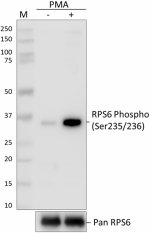
Total cell lysates (15 µg protein) from serum-starved Jurkat... 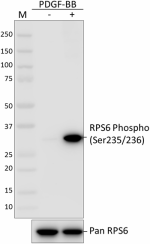
Total cell lysates (15 µg protein) from serum-starved NIH/3T... 
Serum starved NIH/3T3 cells were untreated (panel A) or stim... 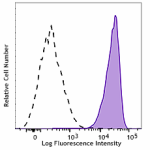
Human peripheral blood lymphocytes were stimulated with (fil... 
IHC staining of purified anti-RPS6 (Ser235/Ser236) (clone A1... 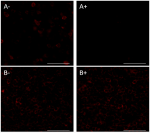
IHC staining of purified anti-RPS6 (Ser235/Ser236) (clone A1... -
PE anti-RPS6 Phospho (Ser235/Ser236)
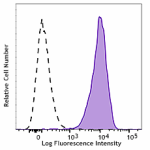
Human peripheral blood lymphocytes were stimulated with (fil... -
PE/Cyanine7 anti-RPS6 Phospho (Ser235/Ser236)

Human peripheral blood lymphocytes were stimulated with (fil... -
PerCP/Cyanine5.5 anti-RPS6 Phospho (Ser235/Ser236)

Human peripheral blood lymphocytes were stimulated with (fil... -
Brilliant Violet 421™ anti-RPS6 Phospho (Ser235/Ser236)
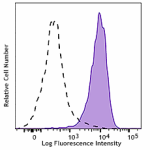
Human peripheral blood lymphocytes were stimulated with (fil... -
Direct-Blot™ HRP anti-RPS6 Phospho (Ser235/Ser236)
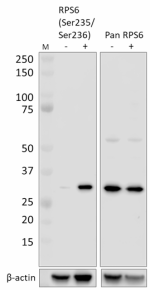
Total cell lysates (15 µg protein) from serum-starved NIH/3T...
 Login / Register
Login / Register 









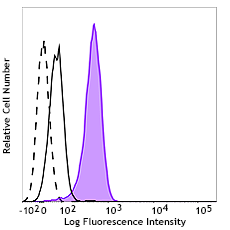
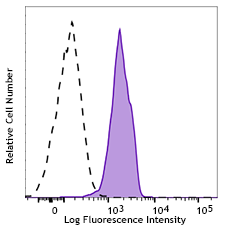
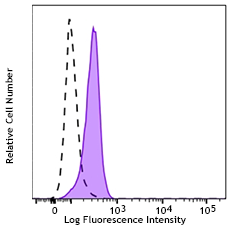
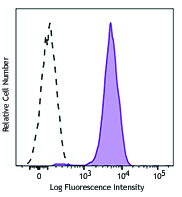



Follow Us